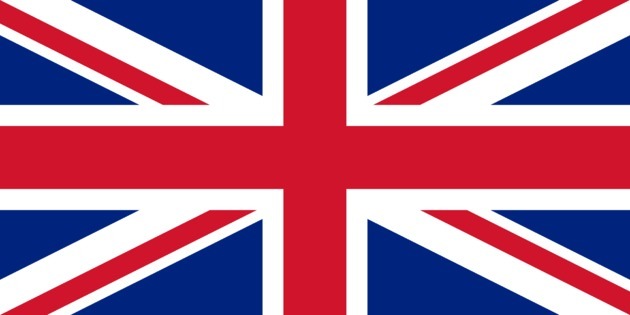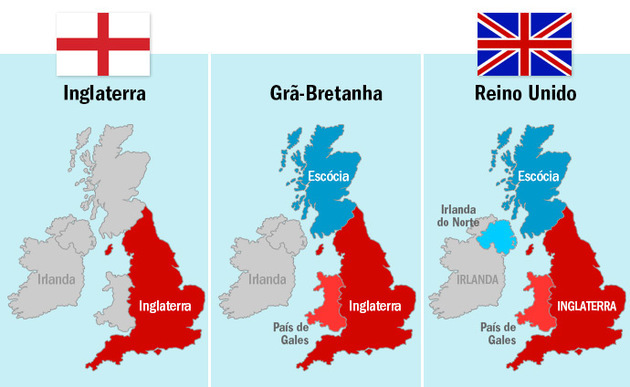O UKfrom Great Britain and Northern Ireland, better known only as UK, is made up of four countries: England, Scotland, Wales and Northern Ireland.
It therefore comprises the archipelago nations of Great Britain plus Northern Ireland. It was created on May 1, 1707, when Scotland and England united their kingdoms.
United Kingdom flag
The flag of the United Kingdom is formed by the symbols contained in the flags of Scotland, England and Northern Ireland.
Wales was never represented in this pavilion, as it is considered part of England, as they have been linked since the Middle Ages.

UK map
In the image below, we can see the islands that are part of the archipelago: Great Britain and the Island of Ireland.

The four countries that make up the United Kingdom appear in the following colors: England in light brown, Wales in pink, Scotland in green, and Northern Ireland in light purple.
The Irish Republic, whose capital is Dublin, appears in pale yellow, and is not part of the United Kingdom.
UK countries
The countries that make up the United Kingdom of Great Britain and Northern Ireland they have a certain degree of autonomy, but are interdependent on each other.
Each has its own parliament, flag and head of government. However, they cannot issue currency, own an army and issue passports. Furthermore, the head of state is the head of the House of Windsor.
Therefore, many claim that the UK is a "country of countries". Let's look at the UK in its entirety and then look at each of these four countries.
UK
- capital: London
- Nationality: british
- Head of state: Queen Elizabeth II
- Prime Minister: Boris Johnson
- Government: parliamentary monarchy
- Population: 65, 64 million (2016)
- Coin: Pound Sterling
- Area: 242.495 km2
- Religion: Anglican, Scottish Presbyterian
- Languages: English, Gaelic and Welsh
England
- capital: London
- Nationality: british
- Head of state: Queen Elizabeth II
- Prime Minister: Boris Johnson
- Government: parliamentary monarchy
- Population: 55 million (2016)
- Coin: Pound Sterling
- Area: 130.279 km2
- Religion: anglican
- Languages: English and Welsh
Wales
- capital: Cardiff
- Nationality: british
- Head of state: Queen Elizabeth II
- Prime Minister: Mark Drakeford
- Government: parliamentary monarchy with a local parliament
- Population: 3 million (2016)
- Coin: Pound Sterling
- Area: 20.779 km2
- Religion: anglican
- Languages: English and Welsh
Scotland
- capital: edinburgh
- Nationality: british
- Head of state: Queen Elizabeth II
- First Minister: Nicola Sturgeon
- Government: parliamentary monarchy with a local parliament
- Population: 5 million (2016)
- Coin: Pound Sterling
- Area: 77.933 km2
- Religion: Presbyterian and Anglican
- Languages: english and welsh
northern Ireland
- capital: Belfast
- Nationality: british
- Head of state: Queen Elizabeth II
- Prime Minister: Arlene Foster
- Government: parliamentary monarchy with a local parliament
- Population: 1,810 million (2016)
- Coin: Pound Sterling
- Area: 13 843 km2
- Religion:catholic, Presbyterian and Anglican
- Languages: English, Irish Gaelic and Welsh
What's the Difference Between UK and Britain?
We can sometimes confuse these terms, as they are often used as synonyms. So, let's look at the map below and see the differences:

Great Britain: this is a geographical term that designates the largest island in the archipelago. There are three countries: England, Scotland, Wales and the islands of Mann, Wight and Jersey.
UK: indicates the union of the countries of Great Britain and a part of the island of Ireland, called Northern Ireland.
UK history

In the photo, the current sovereign, Queen Elizabeth II
The history of the United Kingdom could go back to the division created by the Roman Empire on the island of Great Britain. In order to contain the Picts and other northern peoples, the Romans built Hadrian's Wall in the 2nd century.
In this territory, the future Scotland would be constituted. Importantly, Scotland was traditionally allied with French kings and was an independent kingdom until 1707.
In turn, the tribes that lived in the territory now occupied by England, were gradually becoming Romanized. However, they were unable to face the invasions of vikings and the Romans simply preferred to abandon those lands to defend the southernmost borders of the already decaying Roman Empire.
Centralization of Power
King Henry VIII (1491-1547) was the pioneer in building a powerful fleet that would give the English the necessary protection against their European enemies. Likewise, he broke with the Catholic Church and became head of his own church, the anglican.
Once power is centralized in the hands of the sovereign, England concentrates its energy on defeating its rivals in trade, the Netherlands, and achieves this through the Navigation Act of 1651.
However, it was with the bourgeois revolutions, which strengthened the Parliament and limited the power of the king, that England paved the way to become a world power, through the Industrial Revolution.
Act of Union with Scotland - 1707
The Act of Union of 1707 consisted of the binding of England, Wales and Scotland under the same monarchy, thus creating the United Kingdom of Great Britain. The two crowns had already been united since 1603, but both countries maintained a great degree of autonomy.
For England, the Act of Union was good, as it would end the constant conflicts with this kingdom and remove the French danger from the island once and for all.
For the Scots, the big advantages were economic. Scotland would have access to markets in England and its colonies and the salt and coal industries would be protected
However, they had to resign and have a smaller participation of representatives in Parliament, as well as the right to mint coins and have their own foreign policy.
Although approved by parliamentarians, many Scots did not agree with this union and several rebellions took place during the 18th century against this law.
Act of Union with Ireland - 1801
At the end of the 18th century, faced with the events of the French Revolution, the English pressured the Irish to accept being part of the United Kingdom.
This was due to the constant alliances that the French made with the Irish to destabilize England.
Both houses of parliament reach an agreement in 1801. However, this union would not be easy due to the Irish Catholic majority who started to be discriminated against against the Protestant elite.
In this way, the English army brutally repressed any rebellion by the Irish. In the 19th century, with the bad harvests, there was famine and immigration, and no help from the English government.
All this only increased the feeling of animosity towards the United Kingdom and the pro-republic movements increased, as well as the acts of terrorism sponsored by the Irish Republican Army - IRA, in its acronym in English.
The situation would only be resolved after the War of Independence (1919-1922) that created two countries on the island: Northern Ireland, united with the United Kingdom, and the Republic of Ireland.
read more- Europe
- Europe map
- European Union
- Brexit
- Margareth Thatcher
- Queen Victoria
- Victorian age
- King Arthur
- Queen Elizabeth I
